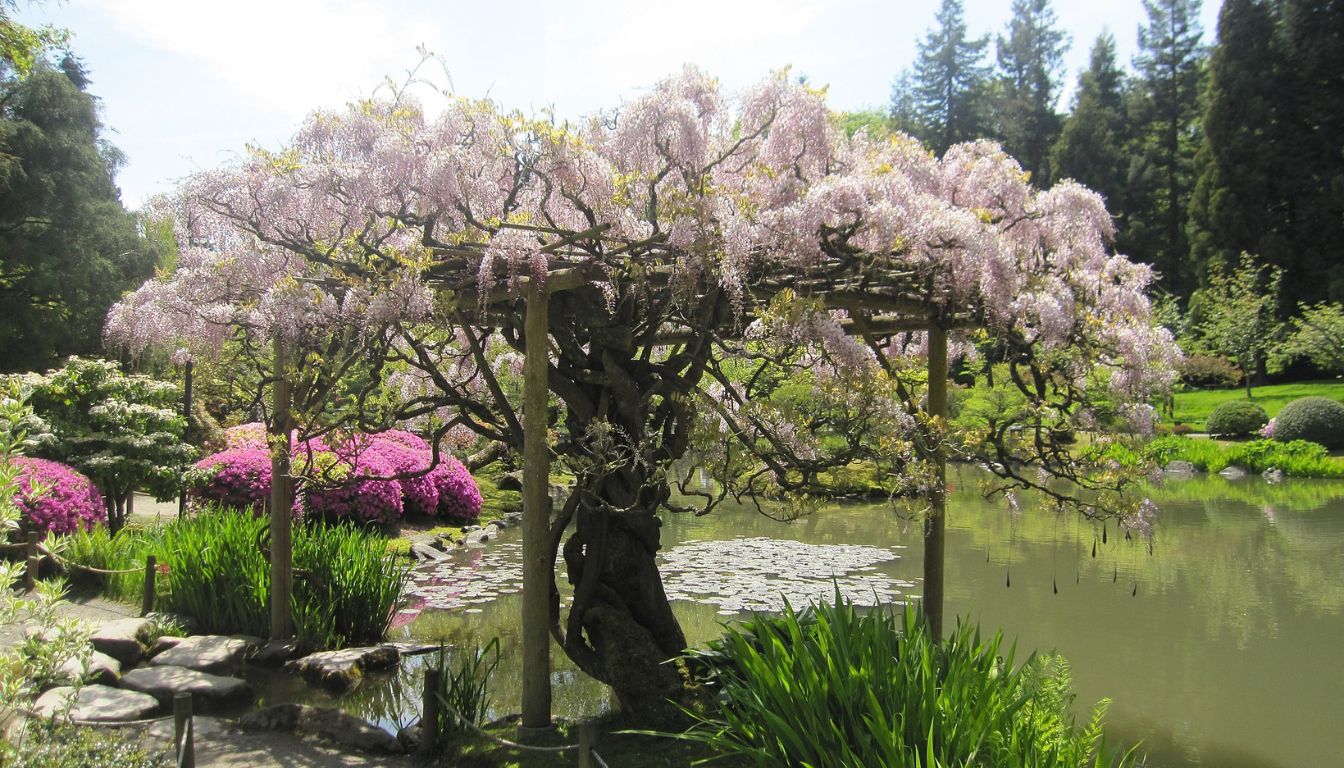When I think of tranquility and beauty, Japanese garden flowers come to mind. These stunning blooms aren’t just visually captivating; they embody a rich cultural heritage and a deep connection to nature. Each flower tells a story, inviting us to step into a world where serenity reigns and every petal holds meaning.
Imagine walking through a meticulously designed garden, surrounded by the vibrant colors of cherry blossoms and the delicate elegance of irises. The harmonious blend of these flowers creates an atmosphere that calms the mind and soothes the soul. If you’re looking to transform your outdoor space or simply appreciate the artistry of nature, exploring Japanese garden flowers is a journey worth taking. Let’s dive into the enchanting world of these blooms and discover how they can elevate your garden and spirit alike.
Overview of Japanese Garden Flowers
Japanese garden flowers showcase a unique blend of beauty and tranquility. Many people appreciate their cultural meanings. Cherry blossoms, known as sakura, represent the fleeting nature of life. These flowers burst into bloom in spring and create stunning pink canopies. They attract lots of visitors who gather to enjoy the sight and take pictures.
Another popular flower in Japanese gardens is the iris. With its striking colors and elegant shape, the iris symbolizes purity and hope. Various iris species thrive in wet environments, making them perfect for incorporating into water features.
Peonies also add charm to Japanese gardens. These lush blooms signify wealth and good fortune. They bloom in late spring and come in shades of pink, red, and white. Expect vibrant colors and sweet fragrances from these captivating flowers.
Lotus flowers deserve mention for their serene beauty. They grow in muddy waters but rise above, seeking sunlight. This characteristic signifies spiritual enlightenment and perseverance. Lotus plants fill ponds with their round leaves and radiant flowers.
Japanese gardens feature seasonal variations, keeping the display fresh year-round. In autumn, chrysanthemums take center stage, loved for their resilience and diverse colors. On the other hand, winter brings subtle beauty with camellias. These flowers add elegance when most others fade away.
Selecting the right flowers transforms gardens into peaceful retreats. I often find that a mix of these blooms creates balance and harmony. Making small changes to the flower arrangements invites creativity and joy, enhancing the overall garden experience.
Types of Japanese Garden Flowers

Japanese gardens feature a rich variety of flowers, showcasing seasonal blooms and perennial favorites. Each flower adds unique beauty and meaning to the landscape.
Seasonal Flowers – The Beauty and Symbolism of Japanese Garden Flowers
Seasonal flowers bring vibrant colors and scents to Japanese gardens. Cherry blossoms bloom in spring, creating a breathtaking display. These fleeting flowers capture the essence of transience, reminding me to cherish each moment. Irises appear next, often in late spring, standing tall and proud with their elegant shapes. They symbolize purity and hope, making them a perfect addition to serene spaces.
In autumn, chrysanthemums flourish, adding rich hues and intricate forms. These flowers celebrate longevity and joy, inviting visitors to reflect on the changing seasons. Finally, camellias thrive in winter, offering beautiful blooms even in chilly weather. They stand resilient and symbolize love and admiration.
Perennial Flowers
Perennial flowers provide lasting beauty in Japanese gardens. Peonies bloom in late spring to early summer, showcasing lush, vibrant colors. Their significance lies in wealth and good fortune, which makes me smile when I see them. Lotus flowers, often found in water features, symbolize purity and enlightenment. They rise elegantly above the water, teaching me about resilience.
Daylilies contribute bright spots of color throughout summer. Their prolific nature makes them a gardener’s delight. Another favorite, the Japanese wisteria, enchants with cascading blooms in shades of purple and white. Its sweet fragrance captures hearts and invites people to linger. These perennial flowers enrich the Japanese garden experience all year long.
Symbolism of Japanese Garden Flowers
Japanese garden flowers carry deep meanings. Each bloom tells a story, reflecting beliefs and traditions. Exploring these flowers reveals their cultural importance.
Cultural Significance – The Beauty and Symbolism of Japanese Garden Flowers
Cherry blossoms, or sakura, embody the beauty and brevity of life. Their delicate petals remind me to appreciate each moment. In Japan, these blooms signal spring’s arrival, bringing joy and hope. Irises bring a different feel. They symbolize purity and hope, often seen in traditional festivals. Peonies, vibrant and bold, stand for wealth and good fortune. You can’t help but smile when you see them flourishing in gardens.
Lotus flowers dive into spiritual symbolism. They represent enlightenment and perseverance, rising from muddy waters to bloom beautifully. Each flower connects to feelings and values deeply rooted in Japanese culture.
Floral Arrangements
Arranging these flowers is an art in itself. In Japanese gardens, balance and harmony guide each display. I enjoy mixing seasonal and perennial flowers. Seasonal entries, like cherry blossoms and chrysanthemums, highlight the beauty of change throughout the year. Perennials like peonies and Japanese wisteria offer steady support.
Incorporating these flowers into arrangements creates stunning visuals. Using variations in color and height adds depth. You’ll find these arrangements evoke emotions and spark conversations. Showcasing Japanese garden flowers in creative ways can delight both gardeners and admirers.
Tips for Growing Japanese Garden Flowers
Growing Japanese garden flowers requires some attention and care. I’m excited to share tips that can make this journey enjoyable and rewarding.
Ideal Conditions – The Beauty and Symbolism of Japanese Garden Flowers
Choose a spot with partial shade and well-draining soil. Many Japanese flowers thrive in these conditions. For example, cherry blossoms appreciate protection from harsh winds, while irises enjoy sunny patches. Maintain soil moisture but avoid waterlogging, as it can harm roots. Regular testing of pH levels can help too, ideally keeping them between 6.0 and 7.0 for most flower types.
Selecting the right time to plant also matters. Opt for spring or fall to achieve the best results. I’ve found that these seasons provide the perfect climate for growth. Create a comforting environment, and the flowers will flourish.
Maintenance Practices
Water consistently to keep the soil damp but not soggy. I check the soil’s moisture before watering to prevent overdoing it. Mulching helps retain moisture and controls weeds, too, so don’t skip that step. Fertilizing in early spring promotes healthy growth. Organic fertilizers can work wonders, your flowers will thank you for it!
Prune periodically to encourage new blooms and remove dead or damaged flowers. Doing this can also keep your garden looking neat. I enjoy the process; it feels rewarding to see my garden thrive. Keep watch for pests like aphids or slugs. Early detection makes a difference, and you can easily handle them with natural pest control methods.
Enjoy the process of growing these beautiful blooms, and embrace the tranquility they bring to your garden. The right conditions and care can lead to a stunning Japanese garden that’s both vibrant and peaceful.
Before You Go – The Beauty and Symbolism of Japanese Garden Flowers

Japanese garden flowers offer a unique blend of beauty and meaning that can truly transform any outdoor space. Their cultural significance and serene presence create a calming atmosphere that nurtures both the mind and spirit.
By thoughtfully selecting seasonal and perennial blooms, I can craft a garden that not only reflects my style but also resonates with the deeper themes of life. The joy of cultivating these flowers and witnessing their seasonal changes is a rewarding experience that brings me closer to nature.
Whether I’m drawn to the delicate cherry blossoms or the vibrant peonies, each flower has a story to tell. Embracing the artistry of Japanese garden flowers enriches my gardening journey and enhances my connection to the world around me.
Don’t forget to add theherbprof.com homepage to your favourites so you don’t miss out on future articles.
References – The Beauty and Symbolism of Japanese Garden Flowers
Little Herb Encyclopedia, by Jack Ritchason; N.D., Woodland Publishing Incorporated, 1995
The Ultimate Healing System, Course Manual, Copyright 1985, Don Lepore
Planetary Herbology, Michael Tierra, C.A., N.D., Lotus Press, 1988
Handbook of Medicinal Herbs, by James A. Duke, Pub. CRP Second Edition 2007
The Complete Medicinal Herbal, by Penelope Ody, Published by Dorling Kindersley
Check the Following Article
Sex and Coffee: Energize Your Mornings, Ignite Your Nights
Mustard Oil for Teeth: Natural Benefits for Oral Care
Effective Natural Remedies for Post-Workout Recovery
Revitalize Your Health with a Simple Natural Detox Guide
Frequently Asked Questions – The Beauty and Symbolism of Japanese Garden Flowers
What are some popular Japanese garden flowers?
Japanese garden flowers include cherry blossoms (sakura), irises, peonies, lotus flowers, chrysanthemums, and camellias. Each flower carries unique meanings and seasonality, enriching the garden experience throughout the year.
What do cherry blossoms symbolize in Japanese culture?
Cherry blossoms symbolize the fleeting nature of life and beauty. In Japanese culture, they represent the transient moments of joy and are celebrated during the sakura season.
How do I maintain Japanese garden flowers?
To maintain Japanese garden flowers, ensure they receive partial shade, well-draining soil, and consistent watering. Use organic fertilizers, mulch to retain moisture, and regularly prune to encourage healthy growth.
When is the best time to plant Japanese garden flowers?
The ideal time to plant Japanese garden flowers depends on the species. Generally, spring is great for seasonal flowers like cherry blossoms, while perennial flowers can be planted in early spring or fall for optimal growth.
Why are irises significant in Japanese gardens?
Irises represent purity and hope in Japanese culture. Their striking beauty and unique shape make them a popular choice for Japanese gardens, symbolizing renewal and new beginnings.
How can I create a tranquil atmosphere in my garden?
To create a tranquil atmosphere, mix seasonal and perennial flowers. Focus on color harmony, varying heights, and fragrant blooms to enhance the calming experience, inviting creativity and peace into your outdoor space.

